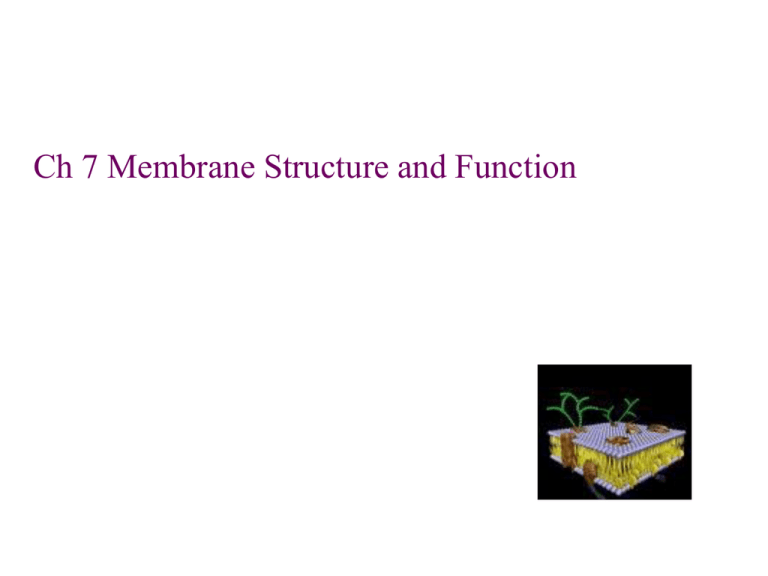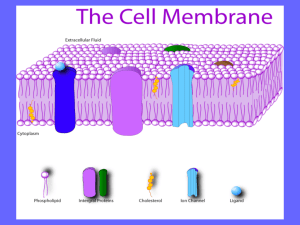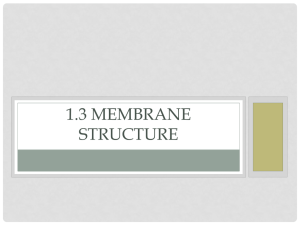Cellular Membranes: Fluid Mosaic Model
advertisement

Ch 7 Membrane Structure and Function Cellular membrane -overall functions - Boundary between intracellular compartments, living cells, and abiotic environment – Selectively permeable – Some molecules cross membranes more readily than others Membrane Structure Predominant constituent: phospholipids • Amphipathic molecules: hydrophobic AND hydrophilic Dispersed protein components Membrane organization and properties described by: Fluid Mosaic Model Singer and Nicolson 1972 LE 7-2 Organization of membrane phospholipids WATER Hydrophilic head Hydrophobic tail WATER Mosaic: something made of small pieces LE 7-3 Mosaic: Proteins dispersed among phospholipids in membrane: Hydrophilic region of protein Phospholipid bilayer Hydrophobic region of protein • Freeze-fracture studies of the plasma membrane • Frozen membrane split along the middle of the phospholipid bilayer using a knife • Imaged by EM Supports mosaic part of model LE 7-4 Extracellular layer Proteins Knife Plasma membrane Extracellular layer Cytoplasmic layer Cytoplasmic layer The Fluidity of Membranes • Phospholipids move laterally within the bilayer • Some membrane proteins also drift laterally • Rarely does a phospholipid flip-flop transversely across the membrane LE 7-5a Lateral movement (~107 times per second) Movement of phospholipids Flip-flop (~ once per month) Effects of Temperature on membranes • Cool temp: membranes switch from fluid to more solid state • Solidification depends on type of lipid • What property of lipids would favor liquid versus solid state? LE 7-5b Degree of saturation of fatty acid tails Fluid Unsaturated hydrocarbon tails with kinks Membrane fluidity Viscous Saturated hydrocarbon tails Steroid cholesterol also component of membranes • Tends to moderate effects of temp. on membrane state • At warm temperatures (such as 37°C), restrains movement of phospholipids • At cool temperatures, maintains fluidity by preventing tight packing LE 7-5c Cholesterol Cholesterol within the animal cell membrane Movement of membrane proteins Can drift within the bilayer – Proteins much larger than lipids--> move more slowly • Cell fusion studies support fluidity of membrane proteins LE 7-6 Membrane proteins Mouse cell Human cell Hybrid cell Mixed proteins after 1 hour Membrane Proteins and Their Functions • Proteins determine most of the membrane’s specific functions • Peripheral membrane proteins – not embedded – attached to extracellular or cytoplasmic surface • Integral membrane proteins – penetrate the hydrophobic core of bilayer – often span the membrane LE 7-7 Fibers of extracellular matrix (ECM) Glycoprotein Carbohydrate Glycolipid EXTRACELLULAR SIDE OF MEMBRANE Cholesterol Microfilaments of cytoskeleton Peripheral proteins Integral protein CYTOPLASMIC SIDE OF MEMBRANE









